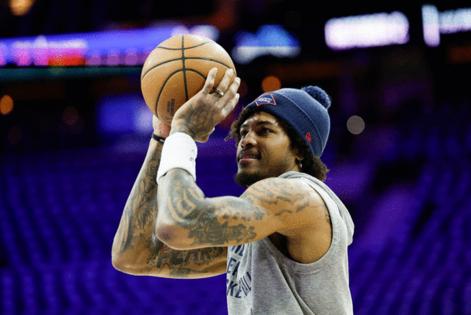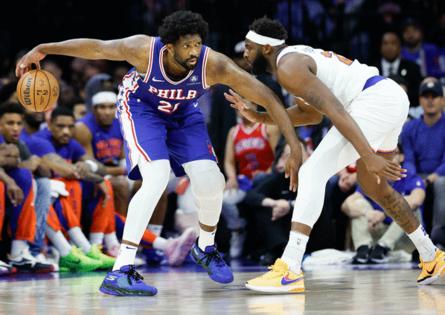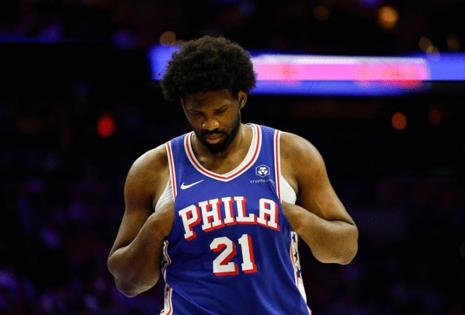David Murphy: The Joel Embiid conundrum will take center stage this offseason
Published in Basketball
The two questions we ask ourselves each May:
1) How much time will Joel Embiid spend on the court next season?
2) How do you build a roster that can survive without him?
I’m talking mostly within the context of a game here. During the Sixers’ loss to the Knicks in the first round of the playoffs, the contrast in their performance with and without Embiid was as stark as it ever has been. They had a whopping plus-45 point differential in the 248 minutes he was on the court during the series. When he was on the bench, they were outscored by 46.
Whenever the topic arises, our focus tends to go to Embiid’s backup. How hard can it be to find a backup center who can give you 10 minutes of satisfactory play? But, then, the question kind of answers itself. The dearth of quality options at the center position is one of the primary reasons Embiid is such a game-changer.
The delta between him and your average big man is off the charts. The law of supply and demand only compounds matters. If you are a big man who is capable of keeping a playoff team afloat when a player like Embiid is off the court, you are probably going to be able to find more minutes on a team that does not have a player like Embiid.
The conundrum lies at the heart of the logical basis for finding a third star. It’s actually more important for the Sixers than other teams, the thinking goes. You aren’t going to find a backup center who can give you even 75% of what Embiid gives you at the position. Which means the best option for succeeding without him is to be better at the other four positions.
Surround Embiid with two elite bucket-getters, and that duo can handle the offense when Embiid is on the bench. Makes complete sense. Of course, inventory levels of elite scorers on the wing aren’t exactly abundant.
A few big questions that will define the Sixers’ offseason ...
1) Outside of Paul George and LeBron James, are there any impact wings who will even be available?
I’m skeptical that the offseason trade market is going to yield what the Sixers truly need. Look at the Pelicans as a case in point. This weekend brought the news that New Orleans was not willing to offer wing Brandon Ingram a max contract extension. Further indication that a shake-up is looming.
Ingram would surely be heralded as a potential superstar wing who could be had for the right price. But, man, if you thought Tobias Harris was a disappointment, just wait until you see Ingram try to get to the rim and finish against a physical playoff defense.
As far as the eye test goes, the most intriguing on-court fit alongside Embiid and Tyrese Maxey would be Miles Bridges. But I hesitate to even bring him up, given the horrific domestic-abuse allegations that sidelined him for all of 2022-23 and led to a 30-game suspension handed down by the NBA.
James and George would both be great fits. I’m not going to waste any more energy on them until we get some indication that either is any more sincere about taking his talents to South Philly than he has been every other time we’ve heard about the potential.
2) What’s Kelly Oubre Jr.’s future?
He’s an interesting case. First, to be clear, he isn’t anything close to the sort of primary scoring wing the Sixers are looking for. But he brought a lot of value this season, and it’d be a shame if we didn’t get to see what kind of growth he’d exhibit in a second year in his role.
Problem is, there are a lot of free agents in his bucket that offer more polish, or shooting, or all-around game. Bruce Brown and Caleb Martin are a couple of the (presumably) attainable ones. Because Oubre was signed on a veteran minimum deal, he would need to be signed using some of the Sixers’ estimated $65 million in salary-cap space or an exception (assuming he played himself into a decent raise).
3) Could the Sixers luck into an immediate contributor in the draft?
It isn’t out of the question. But it also isn’t something that the Sixers will be factoring into their 2024-25 plans.
You can get yourself in a lot of trouble drafting for need in any portion of the draft. The deeper you go, the more foolish it gets.
“Immediate help probably never comes in the draft,” team president Daryl Morey said. “In fact, there’s really only something like less than 10 but greater than five players picked in the range we’re picking in that are good in the first year. That said, we don’t really focus on the draft for help now.”
It’s a shame that Jamie Jaquez Jr. won’t be on the board at No. 16 overall this season, as he was last June. The former UCLA star made an immediate impact for the Heat after they picked him at No. 18 last June. He started their first four playoff games against the Celtics before a strained hip flexor sidelined him for Boston’s clincher, and would fit in awfully nice with this Sixers team. The ideal combination of immediate impact and star upside. Alas, one that is rarely available in the second half of the first round.
4) What about Embiid’s backup?
At this point, we’d be wise to at least expand the conversation to include his eventual successor. The Sixers would certainly be wise to be thinking about it.
One of the big arguments in favor of going all-out for an aging superstar like George would be the opportunity to execute a hard pivot if Year 1 implodes. The Sixers trade Embiid, and utilize the return to build around Maxey.
I’ve long been a proponent of the Sixers using the draft to try to find and develop a player who can serve as Embiid’s backup, given the difficulty in finding such a player in free agency. The Celtics’ Robert Williams plan, although it’s worth noting that Williams was mostly a nonfactor as a rookie.
This year’s draft features a number of seasoned collegiate big men, plus a couple of non-collegiate big men who are projected to go inside the top 10. That would seem to be a good recipe for finding a viable talent later than usual.
Purdue’s Zach Edey doesn’t have the lateral quickness to thrive on the defensive end. Think more Baylor’s Yves Missi. Duke’s Kyle Filipowski is the offensive equivalent.
Morey’s Rockets got some first-year run out of Clint Capela after drafting him No. 25 overall in 2014. Capela played in only 12 games in the regular season as a rookie but was in the playoff rotation as the primary backup to Dwight Howard, playing in all 17 postseason games. The Mavericks are currently getting 20 minutes per night from Dereck Lively II, a 7-foot-1 center and Philly native whom they drafted out of Duke at No. 12 overall last June.
But those are very much the exceptions.
_____
©2024 The Philadelphia Inquirer, LLC. Visit at inquirer.com. Distributed by Tribune Content Agency, LLC.












Comments